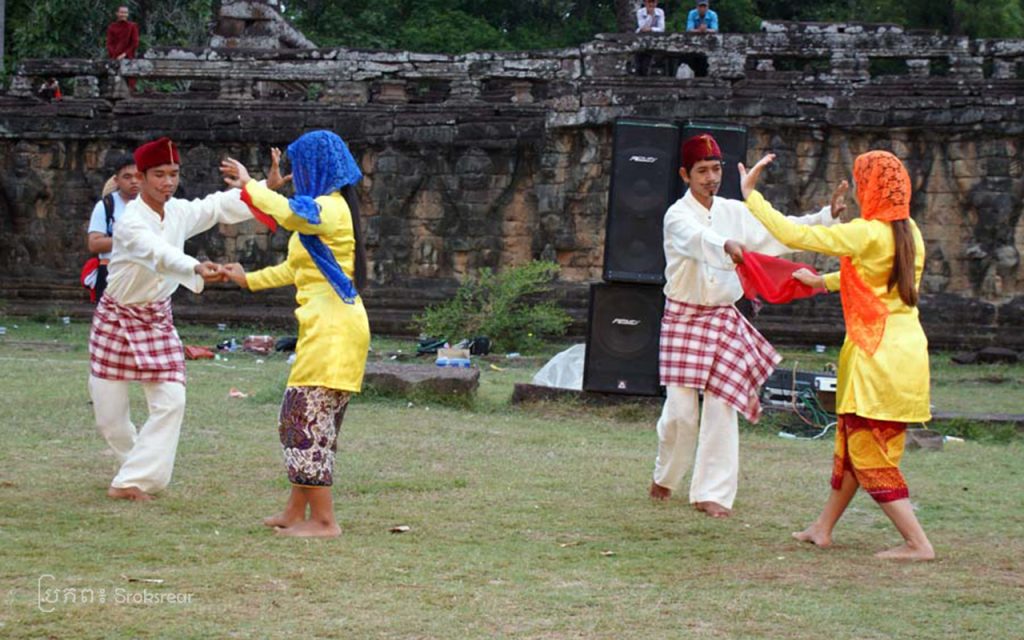ប្រទេសកម្ពុជា មានបាវចនា៖ ជាតិ សាសនា ព្រះមហាក្សត្រ។ ប្រជាជនខ្មែរកាន់និងគោរពព្រះពុទ្ធសាសនា ដែលជាសាសនារបស់រដ្ឋ ចំណែកឯជនជាតិខ្មែរឥស្លាម (ចាម) រស់នៅក្នុងប្រទេសកម្ពុជា កាន់និងគោរពសាសនាឥស្លាម។
លោក ពោ ធម្មា (Po Dharma) បានសរសេរថាមានមូស្លីមប្រមាណ ១៥០,០០០ ទៅ២០០,០០០នាក់ ក្នុងប្រទេសកម្ពុជា នៅឆ្នាំ១៩៧៥។ ប៉ុន្តែការធ្វើទុក្ខបុកម្នេញក្រោមរបបខ្មែរក្រហមបានធ្វើឱ្យចំនួនប្រជាជនគេថយចុះ។ ជនជាតិចាមទាំងអស់នោះសុទ្ធតែជានិកាយស៊ូនីនៃគណៈសាហ្វី។ លោក ពោ ធម្មា បែងចែកជនជាតិចាមនៅកម្ពុជា ជាមែកធាងអ្នកប្រពៃណី (Traditionalist) និងមែកធាងអ្នកគន្ថប្បដិបន្ន (Orthodox) ជាជំនឿដ៏ត្រឹមត្រូវតាមគម្ពីរ។ ប្រទេសកម្ពុជា នៅក្នុងឆ្នាំ១៩៦២ មានប្រមាណ ១០០ ព្រះវិហារឥស្លាម។
យោងទៅតាមស្ថិតិនៃក្រសួងធម្មការនិងសាសនា ជនជាតិចាមមានប្រមាណ ២.៣ភាគរយនៃចំនួនប្រជាជនសរុបនៅកម្ពុជា ហើយក្នុងនោះមានវិហារសាសនាឥស្លាមចំនួន៨៨៤ និងសាលាសាសនាឥស្លាមចំនួន ៣១៤។
របាំកន្សែងស្នេហ៍
នាសម័យដើម ជនជាតិចាមមាននគររបស់ខ្លួន ឈ្មោះ «ចំប៉ា» ដែលបច្ចុប្បន្នជាផ្នែកមួយនៃប្រទេសវៀតណាម។ ប្រទេសរបស់គេលែងមានវត្តមាននៅលើផែនទី ហើយពួកគេក៏ហាក់ដូចជាត្រូវបានគេបំភ្លេចចោល។ ប៉ុន្តែប្រជាជនចាម បានព្យាយាមស្តារខ្លួនឯងឡើងវិញនិងបានតាំងទីលំនៅជាសហគមន៍នៅទូទាំងប្រទេសកម្ពុជា។
ជាមនោសញ្ចេតនាស្វាគមន៍និងភាពកក់ក្តៅ ក៏ដូចជាការកោតសរសើរចំពោះវប្បធម៌ដទៃ សិល្បករនិងសិល្បការិនីនៃសាកលវិទ្យាល័យភូមិន្ទវិចិត្រសិល្បៈបានបង្កើតរបាំកន្សែងស្នេហ៍នេះឡើង ដោយបានយកលំនាំតាមទំនៀមទម្លាប់នៃការចែចង់គ្នារវាងបុរសនិងស្ត្រីចាម។
ជាទំនៀមទម្លាប់ប្រពៃណីឥស្លាម ស្រ្តីចាម នៅពេលចេញក្រៅទៅទីសាធារណៈ គេតែងតែប្រើកន្សែង (ស្បែ) ដើម្បីបិទបាំងមុខ ដូចដែលទស្សនិកជនបានឃើញនៅក្នុងរបាំកន្សែងស្នេហ៍ អ្នករបាំប្រើកន្សែងបក់បោយមានមន្តអាគមដាក់ស្នេហ៍ដើម្បីចងចិត្តគូស្នេហ៍របស់គេ។
ធាតុផ្សំសិល្បៈ មានតន្ត្រី សម្លៀកបំពាំក់ កាយវិការ និងមនោសញ្ចេតនា មានគោលបំណងរួមបញ្ជូលនូវទម្រង់ចាម។ ឧទាហរណ៍ ស្គរយីកេដែលគេប្រើនៅក្នុងរបាំ ជាឧបករណ៍តន្ត្រីចាមដើម។ ដោយឡែក ភ្លេងនិងចង្វាក់គឺត្រូវបានគេនិពន្ធថ្មី និងមានលក្ខណៈងាយស្រួលក្នុងការយល់និងជាសម្គាល់មួយអំពីជនជាតិចាម។

របាំកំចាត់ឧបទ្រពចង្រៃ
របាំប្រជាប្រិយ ដែលសិល្បករសិល្បការិនីនៃសាកលវិទ្យាល័យភូមិន្ទវិចិត្រសិល្បៈបានបង្កើតថ្មីនេះ មានឈ្មោះថា «របាំកំចាត់ឧបទ្រពចង្រៃ»។ អ្នកខ្លះហៅរបាំនេះថា «របាំចាមថ្មី» គឺគេបង្កើតថ្មីក្រោយរបាំកន្សែងស្នេហ៍ ឬ គេហៅខ្លីថា «របាំចាម»។ ពិធីលៀងអារក្ខរបស់ជនជាតិចាម ក្នុងភូមិកំពង់ត្រឡាច ស្រុកសាលាលេខប្រាំ ខេត្តកំពង់ឆ្នាំងបានបំផុសគំនិតដល់សិល្បករសិល្បការិនីនិងក្រុមស្រាវជ្រាវនៃសាកលវិទ្យាល័យភូមិន្ទវិចិត្រសិល្បៈ ក្នុងការបង្កើតនិងតម្លើងរបាំនេះឡើង។
ពិធីលៀងអារក្ខរបស់ជនជាតិចាម ត្រូវបានរៀបចំឡើងបន្ទាប់ពីមានអ្នកមានជំងឺ។ នៅក្នុងពិធី «រូប» ធ្វើការអំពាវនាវហៅព្រលឹងឱ្យមកព្យាបាលអ្នកជំងឺ។ នៅក្នុងរបាំ រូបនោះ តំណាងឱ្យព្រលឹង អ្នកតា ឬខ្មោច មានខ្លះជិះសេះឬទូក ខ្លះដើរនិងរាំ។
ដំណើររឿងនិងខ្លឹមសារក្នុងរបាំកំចាត់ឧបទ្រពចង្រៃ បង្ហាញពីភាពសប្បាយរីករាយ ដោយមានក្បាច់រាំខ្មែរលាយបញ្ចូលផង។ ឯសត្វសេះជាជំនិះ តំណាងឱ្យសភាវៈល្អ ជាអ្នកព្យាបាលអ្នកជំងឺ។ អ្នករាំស្លៀកពាក់សម្លៀកបំពាក់ចាម និងពាក់ចង្រ្កងជើង ដើម្បីបង្កើតជាសូរនិងសំឡេងខ្លាំង និងដើម្បីជួយសង្កត់ចង្វាក់។ ដោយឡែក ភ្លេងចាមដើមត្រូវបានគេរក្សាទុក ប៉ុន្តែគេក៏បានកែសម្រួលបន្តិចបន្តួចដើម្បីឱ្យត្រូវនិងស្របជាមួយនឹងក្បាច់រាំ៕
—————————————–
ISLAMIC FOLK DANCES IN CAMBODIA
The tripartite motto of the Kingdom of Cambodia is Nation, Religion, King. Most of the country’s population are Khmer, who practice Buddhism. Islam is the religion practiced by Cham (also called Khmer Islam) and Malay. According to Po Dharma, there were 150,000 to 200,000 Muslims in Cambodia in 1975. Persecution under the Khmer Rouge eroded their numbers and they probably have not regained their former strength. These Muslims are Sunnis of the Shafii school. Po Dharma divides the Muslims in Cambodia into a traditionalist branch and an orthodox branch. They have their own mosques of about 100 in Cambodia in 1962.
According to the statistics of the Ministry of Cult and Religious Affairs, Muslims make up some 2.3 percent of Cambodia’s population, and there are 884 mosques and 314 Islamic schools.
Robaim Kansaeng Snae (The Magic Scarf Dance)
At one time, the Cham had their own kingdom known as Champa, which is now part of Vietnam. After losing their territory to the Vietnamese, today, their country is no longer shown on the map, and they are somehow forgotten. However, some of them have managed to restore themselves and have resettled in small communities scattered across Cambodia.
As a warm gesture of welcome as well as an appreciation of other cultures, artists of the Royal University of Fine Arts created the Magic Scarf Dance which adapts the Cham custom of expressing courtship between the sexes. Cham women seem shy. During the day, if they need to go out, they use the veil to cover their face. In the dance, dancers use scarves, representing the veils, to magically court their lovers.
The musical element is intended to embody the Cham style. The large-framed yike drums are used; they are the original Cham instruments, whereas the music and its rhythms are newly composed and bear the easily recognizable flavor of Cham.
Robaim Kamchatt Uppatrup Changrai (Ward-off the Evil-Spirit Dance)
This newly created folk dance is called Robaim Kamchatt Uppatrup Changrai or Ward-off the Evil-Spirit Dance. It is sometimes referred to as Robaim Cham Thmey or the New Cham Dance. It is “new” because there existed an “old” Cham dance known as Robaim Kansaeng Snae (Magic Scarf Dance) or in short Robaim Cham (Muslim Dance).
A research team and artists from the Royal University of Fine Arts were inspired by pithi lieng arakk (worship of the spirit ceremony) of the Cham in the Kampong Tralach village, Sala Lek Praim district, Kampong Chhnaing province. The worship of the spiritual ceremony of the Cham is similar to that of the Khmer conducted after a sick-person is healed. In the ceremony, the medium invokes the spirits to come and heal the sick-person. The medium, representing the spirits or ghosts, come riding horses or boats; some walk and dance.
The dance story presents female dancers expressing their happiness interspersed with traditional Khmer dance movements and gestures, while the horses represent the good spirits who heal the sick. The costumes worn by dancers are the adaptation of the Muslim costumes. Dancers wear ankle-bells to create loud sounds and noises and to accentuate rhythms. The original music is kept but with slight modification to fit the dance choreography.
អត្ថបទដើម៖ បណ្ឌិត សំ សំអាង






